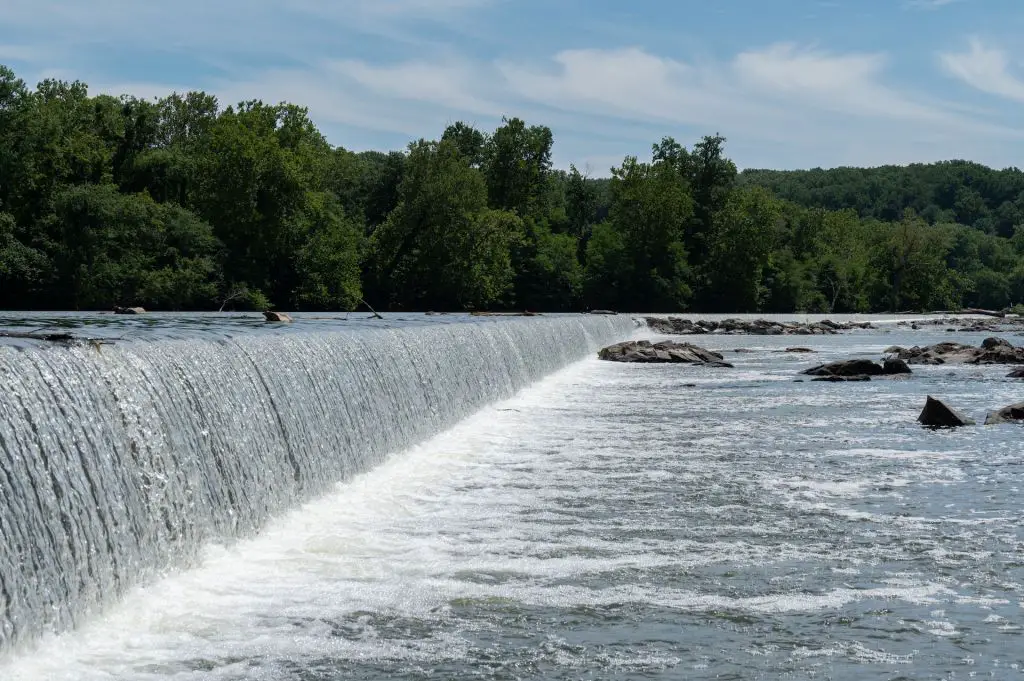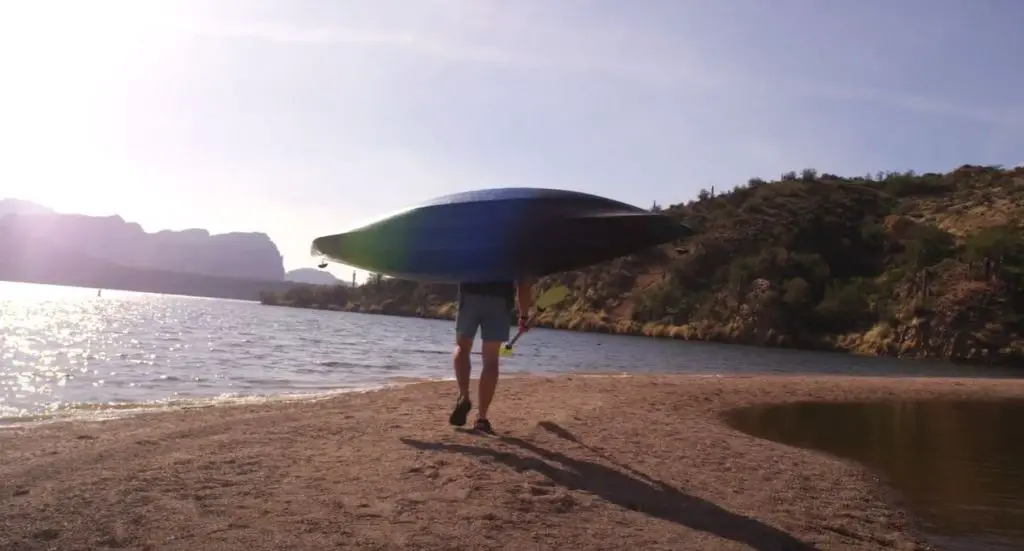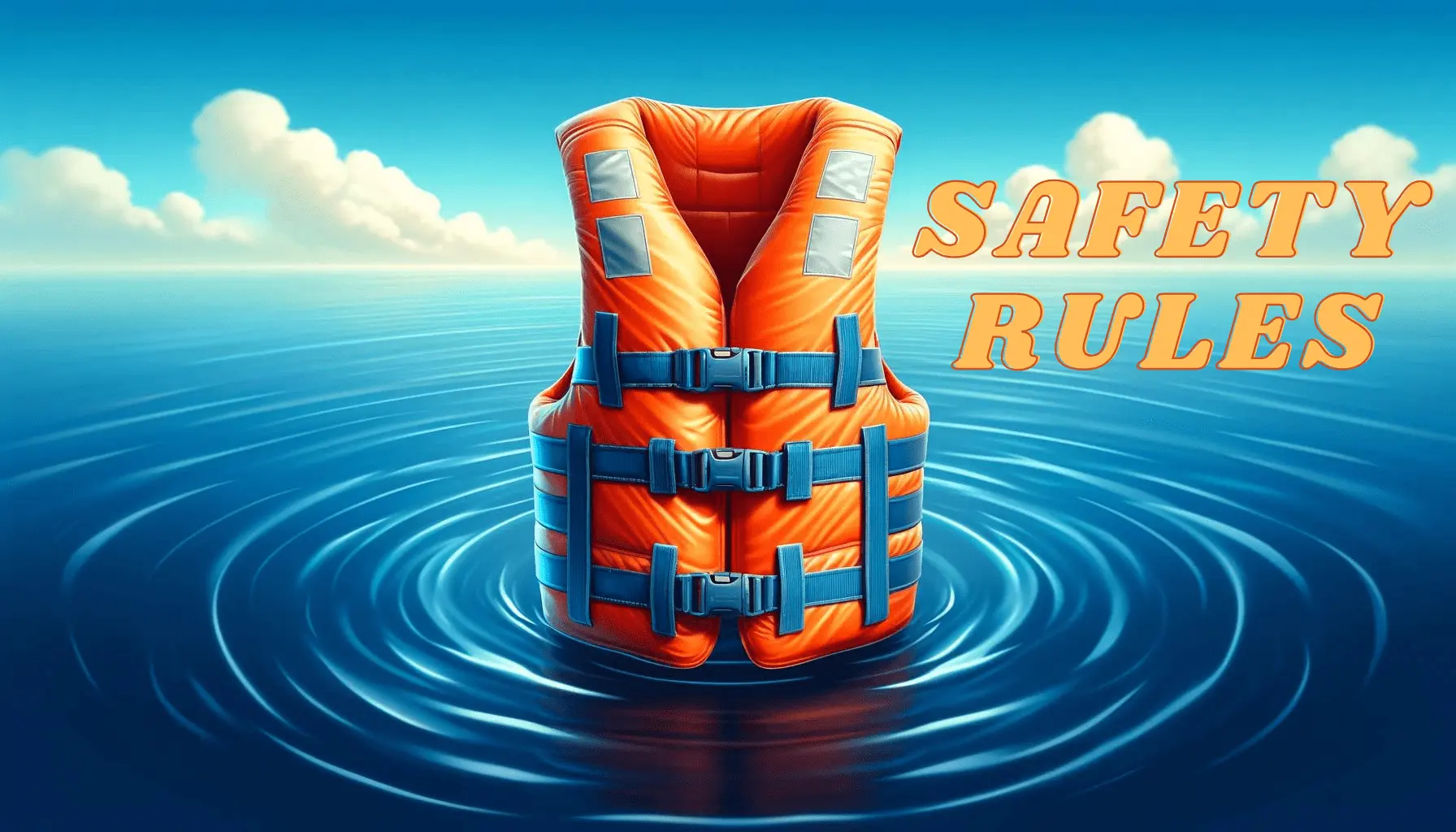What is a low-head dam? Let me quickly answer this with a warning. Low-head dams are easily the single most dangerous thing for a kayaker. It is important that you know what it is and how to escape a low-head dam.
Also known as a weir, a low-head dam is an obstruction that runs across a river. It has many effects on the river, but the one that must concern us kayakers is its ability to drown people.
Another name for a weir or low-head dam is “drowning machine.” And it can take a few minutes for the energy from the “undertow” to peel your skin, smash you against the bed of the channel, break bones, and cause you to drown.
We must seriously discuss what it is, how to protect yourself while paddling, and how to escape a low-head dam when you do run into one.

What Exactly Is A Low-Head Dam?
A low-head dam is a manmade device that runs across a river or stream. Its purposes are to raise the water levels for irrigation and industrial water supplies.
The low-head dam increases the water level upstream, which causes a quick but short drop in the water level going downstream. On the surface, the waterway looks tranquil, especially the section before the dam.
The water is quicker downstream but not as turbulent as other rivers. However, that portion is called a “jump” where the water drops. This is where the slow-flowing water meets quicker-flowing water—the most deadly part of the low-head dam.
At this point, water circulates turbulently below the surface. This is called a “boil” and anything that falls into this area can be trapped until a bigger force than the “boil” can pull the object downstream.
This is the area that has caused numerous deaths for recreational swimmers, kayakers, and sometimes their rescuers.
Unlike the high-rising dams we know of, low-head dams can be anywhere from a few feet to 18 inches tall. But don’t let their low profile fool you; they are deadly because of one characteristic called the “boil.”
The video below describes in detail the forces and physics in the water that allow such a thing to happen.
Additionally, the video explains why these dams, which are no longer useful today, continue to exist.
The particular challenge with low-head dams is that they are neglected infrastructure from over a century ago. They are not well documented, and the low-head dams have outlived their usefulness.
It also doesn’t help that in the early days, governments did not consider them a threat because they looked serene upstream and not as turbulent downstream.
It wasn’t until recreational swimmers, kayakers, and boaters were being killed by the “drowning machines” that they realized low-head dams were deadly.
What Are The Warning Signs That A Low-Head Dam Is Near
Now that we know low-head dams are the most dangerous dams, largely due to them having more fatalities than full-sized dams. We should also know the warning signs so that we know how to escape a low-head dam before it’s too late.
However, some general warning signs, that there might be an upcoming dam, include;
- The water moves quicker than usual.
- The water becomes choppy or muddy and is unusually turbulent.
- There is debris or foam in the water.
- The banks around it are severely eroded.
- It’s difficult to spot, nearly invisible structure,
- The consistent, steady roar of water
- Change in water’s current
- Presence of a waterfall or rapids
- Unmarked
- Strong currents that can suck in boats, people, and debris
- Floating debris
- Recirculating current (boil) that can pull and trap people underwater
- Difficult to escape and rescue
Low-Head Dams Are Hard To Escape & Rescue Is Difficult
This video is highly recommended. It explains how low-head dams are extremely dangerous with examples and stories. It also gives the history of various accidents and serves as a warning to the public.
As seen in the video, rescue is difficult, but for it to be truly effective, there needs to be downstream rescue facilities on standby.
The expense of such facilities has gotten some governments to implement policies for the destruction and removal of these low-head dams.
In the video above, the kayaker that went over was extremely lucky to have other kayakers behind him who understood the dangers of a low-head dam.
The rescuers were knowledgeable and sprung into action quickly to rescue the fallen kayaker.
In this case, the following kayakers seem to have been prepared for the eventuality that someone would get caught in the tow of a low-head dam.
However, this type of rescue is rare. Why? Typically, firefighters or a special task force depending on where you live will come to the rescue, and it could take several minutes before they arrive.
How To Escape A Low-Head Dam
The most difficult thing about a low-head dam is that it is hard to spot. We listed the warning signs of a low-head dam above so that you can avoid them.
So, surely there must be techniques to know how to escape a low-head dam, right?
The short answer is yes, but realistically, the answer is no.
The reason for the conflicted answer is simple. For example, if you get caught in the “boil” of a low-head dam, your only escape is going to come from rescuers.
Earlier, we saw how to escape a low-head dam, but it came from being rescued. In that case, I consider it lucky.
Since time is a factor in drowning, the more time spent in the “boil,” the less likely you are to survive. Remember, the other name for low-head dams is “drowning machines.”
Conditional Rescue And True Rescue
For professional rescuers, there are two major categories of rescues for low-head dams. Once you have fallen over and crossed the jump, rescue is the only effective way to escape a low-head dam.
We have conditional rescue, which requires the victim to actively participate in their own rescue. They will need to catch a throwline from the bank or a boat downstream. If the victim cannot assist in their own rescue, this method will fail.
Second, we have a true rescue, which involves only the skill of the rescuers and not the victim. However, this can be expensive for governments, and it may take too much time to complete a rescue.
Therefore, rescue is not an option we should bank on. We must proactively plan to stay away from a low-head dam. You can view it as the “point of no return.”
We’ve seen even firefighters on a rescue mission lose their lives getting swept by the “boil” of a low-head dam.
Let’s say you are paddling along a river and realize you are approaching a low-head dam. What can you do to rescue the situation? Please pay careful attention!
There are three things you can do, however, and they are all based on avoidance. That is avoiding a low-head dam altogether. As I’ve established, low-head dams are extremely powerful and deadly, especially when you get into the “boil.”
Please, please, take these precautions if you are kayaking along rivers.
Plan Your Route And Research Nearby Waterways

Get old maps and check your favorite mapping application to note where they could be. I would go further to explore the waterway route you want to navigate on foot to check for a low-head dam.
When you map where low-head dams are, you can plan your adventure to avoid these deadly dams.
You will want to avoid routes that have low-head dams. I don’t recommend even getting into the water where a low-head dam may be.
Always Maintain A Safe Distance If You Approach A Low-Head Dam
If you still can’t avoid a low-head dam after carefully planning your route, you should keep a safe distance. A hundred feet may not be enough.
If finding this low-head dam was part of your plan, give yourself some leeway in your calculations.
Paddle upstream as best you can, and then head to the closest bank. Again, you may need to plan this maneuver in fine detail. No matter how calm the water may appear, please do not attempt to cross the low-end dam.
Paddle To The Shore And Go Around The Dam If You Need To Pass

Again, the low-head dam should never be approached by paddling in the water. Paddle to the banks, land on the shore, and carry your kayak around the low-head dam.
Even a motor on your kayak cannot save you from the “boil,” as that undercurrent will suck anything up and recirculate the water with great force.
Crossing the “jump” is a huge risk because you may forget exactly where the dam is and fall into its trap.
It would be better to avoid the dams altogether and ask locals for such a landmark. Especially if you cannot find any markings on maps.
Crossing the dam on foot, carrying your kayak and gear across, should only be an option if there are no alternative paths.
Even though it may be frustrating to carry your kayak on foot, it is better than risking death by drowning. Passing on foot is the best option you have.
Conclusion
Basically, we know what a low-head dam is, and we know it is the single most deadly thing for kayakers. We now know that it is almost impossible to spot, but we have discussed the signs, so hopefully you can find low-head dams.
You also know that rescue is extremely difficult or nearly impossible in some situations. This is because of the time factor to expect a rescue.
Therefore, we cannot rely on being rescued before drowning.
However, interventions are being made by the government to either make low-head dams safer or remove them completely.
Still, we know that not all low-head dams have been documented and that researching and planning your waterways are very important to escaping low-head dams.
Now that you know how to escape a low-head dam, it would be best to follow the guidelines. It will also be useful to know if it is safe to kayak in flood waters, below you can find an article about it.
Is it safe to kayak in flood water? Here you will find the answer.
However, if you go kayaking on a lake or in the ocean, you won’t have to deal with low-head dams. Low-head dams are prevalent on rivers and streams inland.
So, if you plan on river kayaking, research, plan, and be safe.



